Why do you want to go windsurfing?
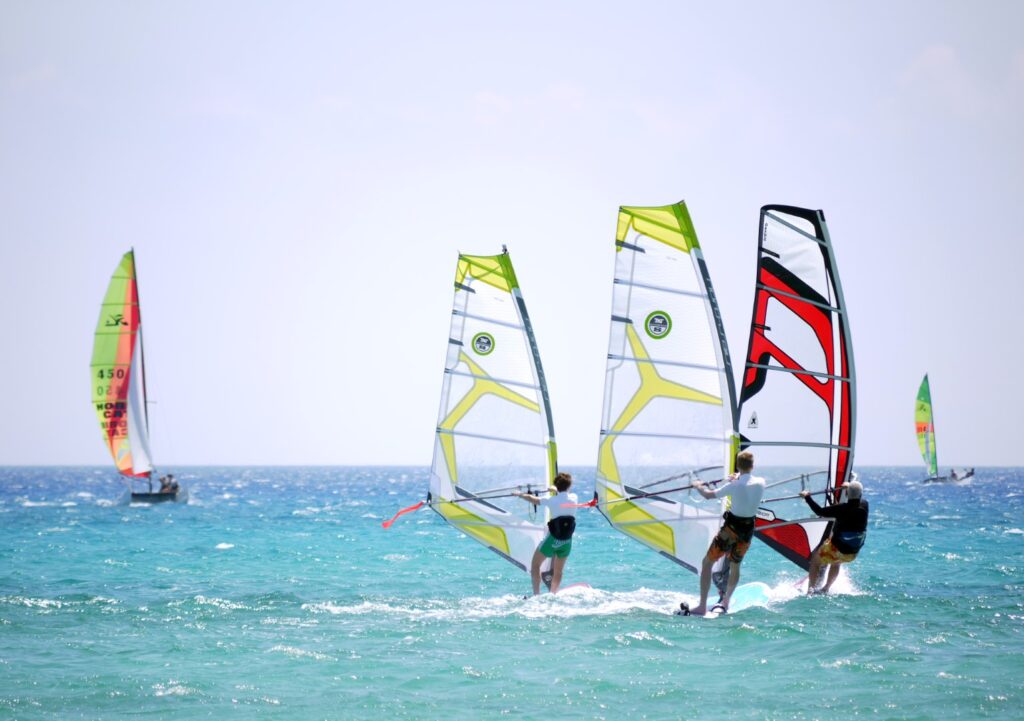
So if you found this page, you probably already have a passing interest in learning about windsurfing. If you’re like me you probably tried it out a few times during vacations or trips to resorts or beaches, the half-hour lesson with some heavily tanned instructor was probably not too deep but just enough to get you on the board and cruising around, and of course falling in the water.. if this was you then perfect this this post will explain how to begin exploring your windsurfing journey…..
If you never have been Windsurfing at all , but are just curious, let me tell you its a heck of a lot of fun, and actually not that hard to get started… and while I only took up the sport in my middle age years, I’m totally hooked. First and foremost windsurfing is primarily sailing , a very pure and basic form of sailing, and its still pretty magical experience to me, to pull up a sail and get propelled though the water with nothing more than the wind, the feeling of sailing along the beech with the wind in your hair and the water flowing quickly past your feet is pretty thrilling. As you advance you can do a lot more “surfing” than just sailing, there’s a whole dictionary of tricks, and there’s wave windsurfing, which is basically a true combination of surfing and sailing.. and the list goes on..
When did it start? a very very brief history…
I’ll keep this very very short.. but it goes something like this, at its core windsurfing is just a very pure form of sailing, so in reality its just an offshoot of the history of sailing which goes back thousands of year…
sidenote: find out more about the fascinating of ancient sailing with this entertaining video TedEd video on Polynesian wayfinders
Windsurfing specifically the sport started in the 1960’s Windsurfing and it started its life as “Sailboarding” , thanks to inventions like the universal joint (swivel point of the sail) , adapting sailboats sails for the smaller boards for recreational use and creation of custom rigging for the booms and mast allowed windsurfing to grow. Here’s an old-timey video of the beginnings.
From there the sport evolved , and as interest grew, the surf culture and its desire for innovation, began creating custom boards and equiptment just for windsurfing, and reached the height of its popularity in the 80s and 90’s along with the resurgence of surfing culture. It was taken to the next level by competitive windsurfers like Windsurfing legend Robby Naish who made the sports spiritual home of Maui Hawaii, the go to destination . This led the way to all sorts of variations of the sport such as wave sailing, windsurfing tricks and flips , slalom racing, indoor windsurfing etc.. Windsurfing became an Olympic sport for the first time in the 1994 Olympics. , and falls under the sailing category.
Since then , the equipment evolved quite a bit with lots of specialization, mostly thanks to better materials for sails, lighter materials like carbon fiber for masts and booms , and lets not forget lighter custom made for windsurfing boards with the latest in designs and materials technology, this has made the sport into what it is today, while it’s popularity has declined since the 90’s due to competition from its cousin sport Kiteboarding, it’s nonetheless a fun outdoor activity almost anyone can enjoy.
Windsurfing vs. Kiteboarding
While windsurfing’s popularity peaked int the 90’s , the new kid on the block kitesurfing enjoys that status today. They are similar sports in that you use the wind and a board, but very different in how you go about doing that.. Keep in mind kite surfing (or kiting as its more commonly referred to today) , is a more extreme and difficult to learn sport. It’s learning curve is longer and will require more time on the water before you get the fundamentals of maneuvering the kite as well as basic sailing.. Windsurfing has a much shorter learning curve, although mastery of the sport may take equal as long. Anyways here’s a brief pros and cons table for each activity.
..you’ll prefer Windsurfing if…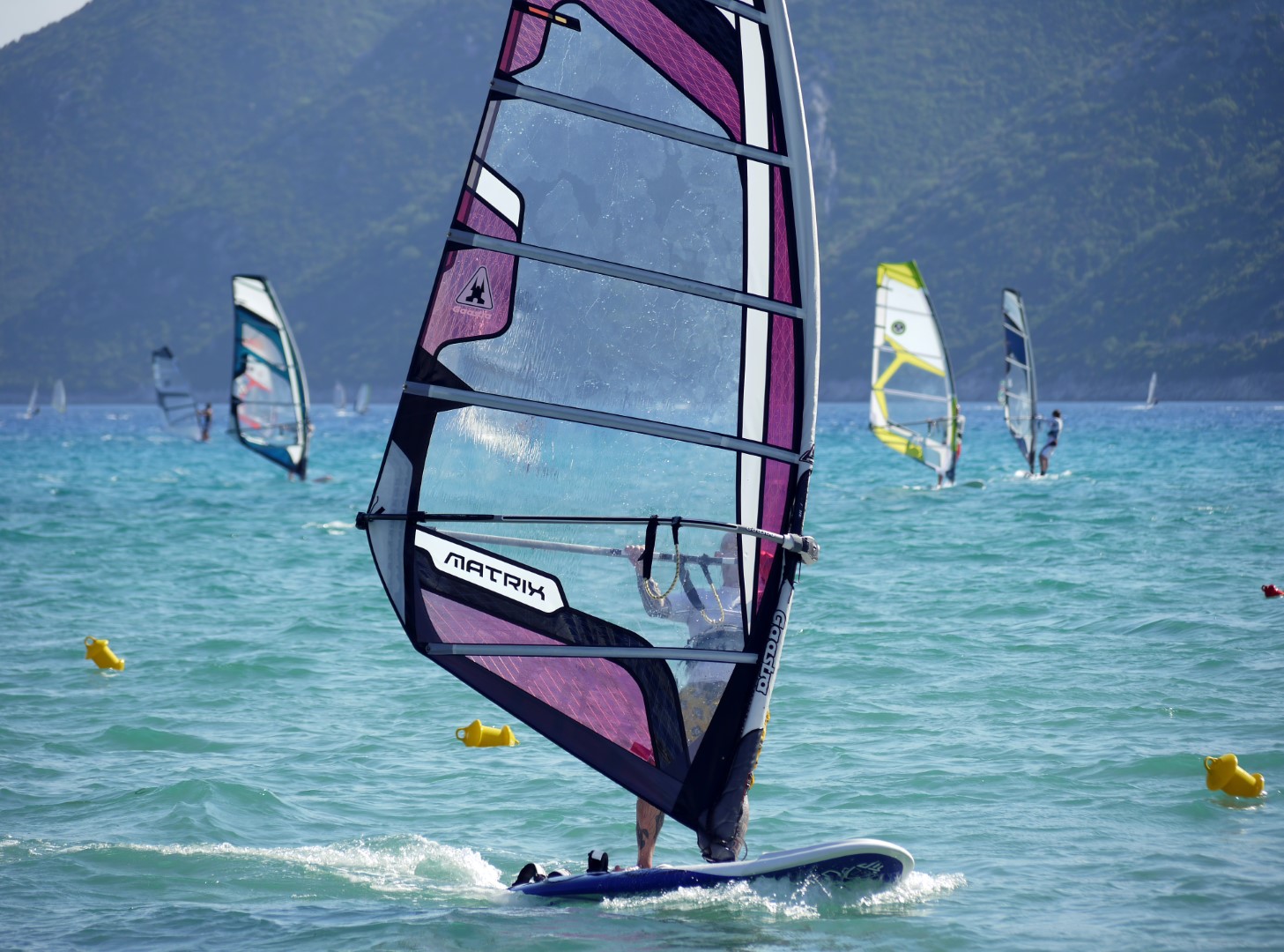 | ..you’ll prefer Kiteboarding if… 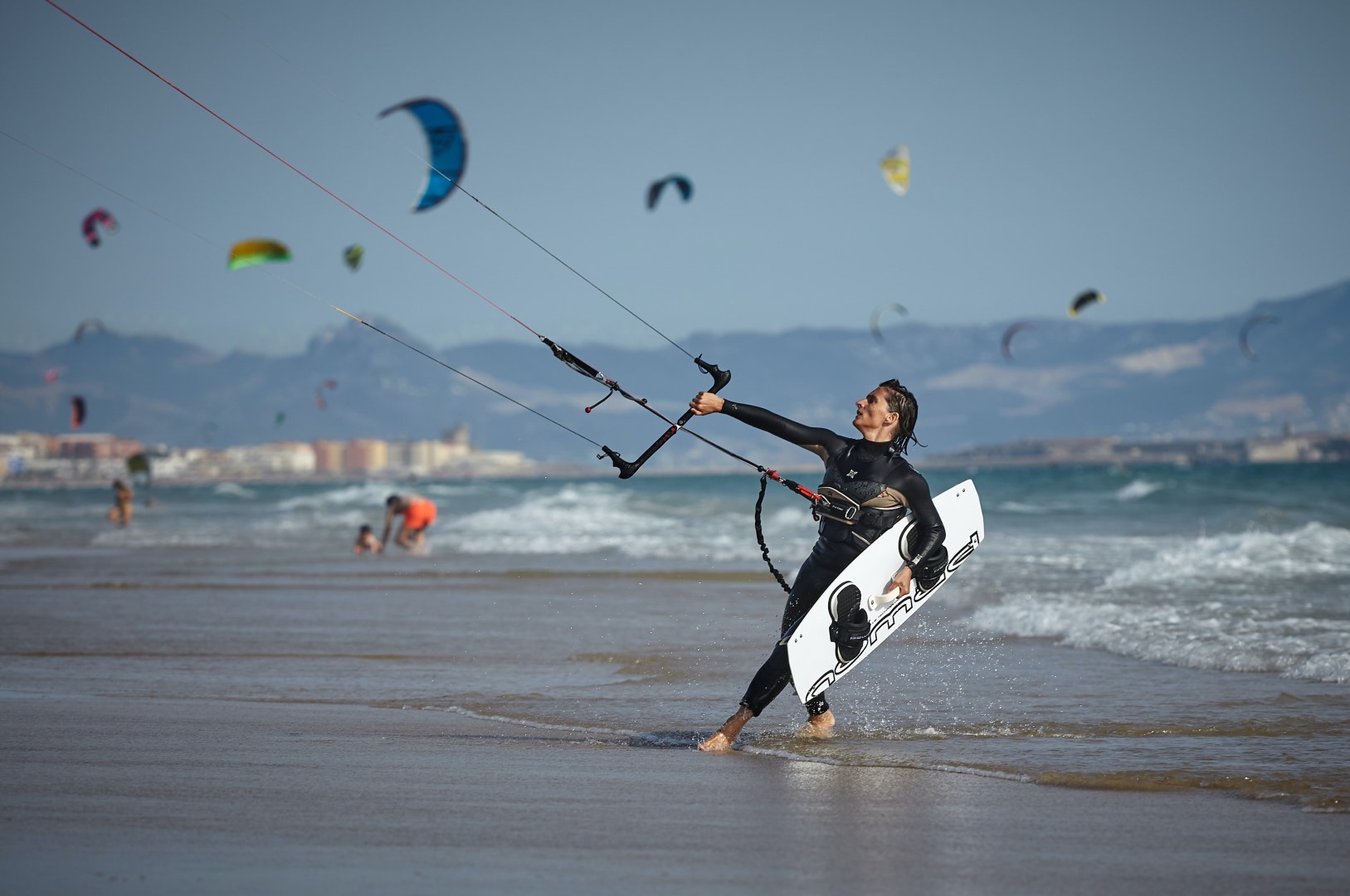 |
| you want a easier learning curve, get on the water and go without less technical training. Have previously surfed before. | you’re willing to spend time learning to fly a kite on land, and have some experience with things like wakeboarding.. |
| You don’t mind lugging around a heavier board, sails, boom and mast. | you prefer less bulky gear something that you can carry on your back and is easier to travel with |
| you don’t mind assembling and disassembling the gear for about 10-15 minutes before you get on the water. | You’re a disciplined person but can handle a little risk |
| You have a big car and spare storage space at home | You have access to a large sandy beach, or large space to launch and land a kite |
| Acrobatics and stunts are not your priority | You have a budget of about $2000 |
Windsurfing: the Basics and lessons
he best way to learn windsurfing is with in-person lessons, since those usually will have all the equipment along with a trained instructor who can guide you through the steps. the next best way is via an instructional video, so I’ll link a few instructional videos below to cover the basics.
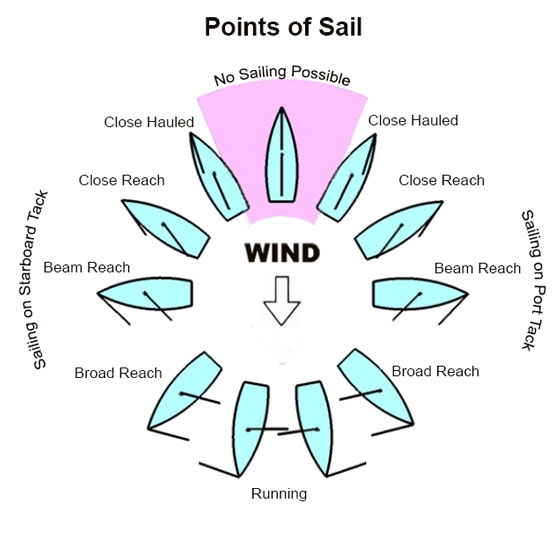
The first step in windsurfing is learning the points of sail, just like sailing. All this means is that you need to sail at an angle to the wind anywhere from 45 to 315 degrees downwind. Most typically you will sail at a 90 degree (perpendicular, known in nautical terms as a beam reach) to the direction of the on-coming wind. In windsurfing this means you always want to start with the wind at your back and the sail in front of you, and you will sail perpendicular (90° ) to the wind.
Next you’ll get on the board with your feet along the centerline (wind at your back) , then in this position , and hoist (uphaul) the sail , as it begins to come up straight , you’ll need to carefully balance yourself and lean the upright sail slightly forward to “catch” the wind. When the sail is mostly upright, you then pull back on the boom, to increase the power in the sail and begin sailing away.
That’s the fundamental way to start. Of course, balancing yourself on the board when you’re first starting is tricky and expect to fall into the water many time. But eventually you’ll get the hang of it and get a feel for the wind pushing against the sail and your counterbalance force with you arms on the boom.
Once you’re sailing you’ll want to steer, this is accomplished but tilting the sail, forward to steer (turn) away from the wind , or tilting it back to to steer into the wind. Keep in mind the points of sail illustration above to understand how much into the wind you can turn, after a certain point you’ll stop. This is where the concept of tacking, (zig-zagging upwind) from size to side to make progress up-wind.
To turn around 180s which is the typical thing you do in windsurfing to come back to the beach, you need to either tack, turn the nose into the wind, or gybe, turn the tail of board all the way away from the wind. Learning these two turning techniques are the next basic things you need to learn.Theres a bit of mechanics to describe everything so it’s just easier to view it .
Below is one of the best instructional videos on Windsurfing on Youtube, its about 14 minutes long and covers the very basics..
From there it’s refining your techniques and spending a lot of time on the water to get the hang of the basics. It may be frustrating at times, but hang in there, you’ll make progress, I guarantee it.
What Windsurfing gear do i need?
Now that you know know the basics and your interested, to start Windsurfing you’ll need several pieces of equipment. Its generally recommended when starting out to take a few lessons on rented equipment, so you don’t incur the expense of the equipment until you’re sure you want to get into the sport. Once you’re ready to take plunge here is what you will need .., The most obvious is a windsurf board (similar to , but larger than a surfboard with mounts for the sail) , and the sail + boom + mast + u-joint, all these together are called the rig.
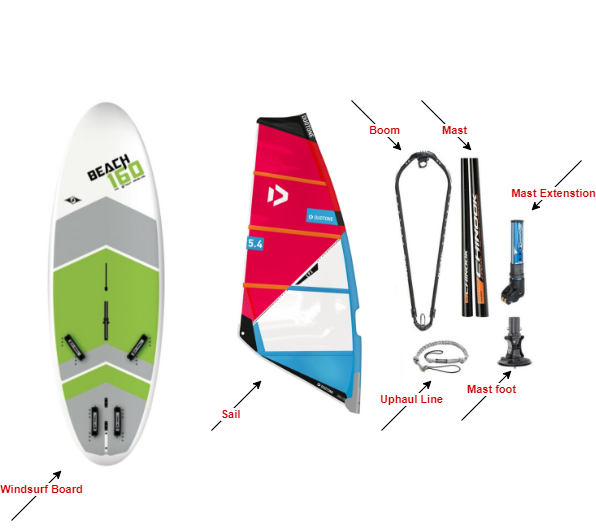
- Windsurf Board (Beginner): this is the most obvious and expensive piece of gear you’ll need. Boards come in all sorts of shapes and sizes. Windsurf boards are very different than regular surfboards, since they are mostly pulled through the water by the wind.. As a beginner, your looking for a beginner board, which is a larger, wider board with more volume (volume means how much water it displaces) , more volume means more floatation and easier to learn on. Volume is given in liters (L) typical board sizes for beginners are 160-240L , as a rule of thumb try to get a board in Liters that is equal to your body weight in lbs. (round up). So if you weight 180lb try to get a board that’s 180L-200L. The next thing to consider, nice to have but not essential, is a daggerboard, this is a retractable fin in the middle of the board, that makes it easier as beginner to sail up-wind (into the wind), most windsurfing boards for more experienced sailors do not have this , but as a beginner this will greatly assist you in going upwind and making the board more stable.
- Windsurf Sail: Windsurfing sails come in even more variety of shapes and sizes than the boards. The most important thing about the sail is its area, expressed as square meters. You’ll want to get a sail that is large enough to move you through the water, but not so big that it’s hard to handle. The actual size is determined by a lot of factors, but the two most important ones are ; the typical wind speed at your most common surfing location and how heavy of a sailor are you. You’ll find that the sweet spot for most beginner s is between 4.0M2 (lighter sailor, or strong wind location)- 6.0M2(for heavier sailor, or lighter wind location) square meter sails.
- Mast: The mast is the large tube, that acts as the sail’s spine ,its detachable into two segments,when joined, it slides into the sail sleeve and is connected to the board via an extension and mast foot (u-joint). The mast is usually two piece and most masts today are a blend of carbon-fiber and other polymers . The actual mast size typically has to be determined after you decided on the sail size. Each sail has on it the dimensions of what mast you need. Windsurfing masts typically come in 30cm increments, from 370cm, 400cm , 430cm, 460cm etc.. the extension makes up the difference to the next size. Also masts come in two diameters, SDM (standard diameter mast) and RDM (reduced diameter mast) , the trend is toward RDM which is a smaller size but either one is fine, just make sure it fits your sail.
- Boom: the boom is your handle to control the mast and sail, it connects to the mast with a clamp at the front , and the sail is attached (tied) to the other end of the boom (the clew end), you then apply tension to the outhaul to give the sail its shape. All booms are adjustable to accept a wide range of sail sizes. Booms come in both aluminum and carbon fiber materials.
- mast extension: This is a short piece of aluminum tube that goes into your mast at the bottom and its what is connected to the board. The extension allows you to adjust the mast height based on the sail size (all sails have this information clearly printed on them). This is also where you tighten (apply tension, downhaul tension ) to your sail with the rope and pulleys attached to the bottom of the extension. The process of setting up your sail is called rigging .
- mast foot (u-joint): This is what connects your board to the mast extension and serves as the connection between the mast and the board. There are different types of universal joints, most have a metal pin the slides into the mast extension bottom.
- uphaul line: A type of rope of line that will allow you to uphaul (lift) the sail out of the water.
- Life vest /Floatation: This can simply be a regular water safety vest or a windsurfing specific impact vest, something to keep you floating near the board when you fall off.
- Harness (intermediate); A harness is a piece of equipment you won’t need until you’re more experienced, but basically it hooks into harness lines attached to the boom and that allows you to use your body weight to pull in the sail to relieve pressure from your arms as you take more power through the sail.
The other thing about the gear is the rigging. This just means the work of assembling the sail, the mast, boom and board, when you arrive at the beach. This is one of the semi-frustrating parts of the sport, because unless you have the convenience of storing the rig pre-assembled at the location where you go sailing (like at your beach house), you will need to do this each time. It’s about 5-15 minutes of rigging your equipment before you go out on the water.
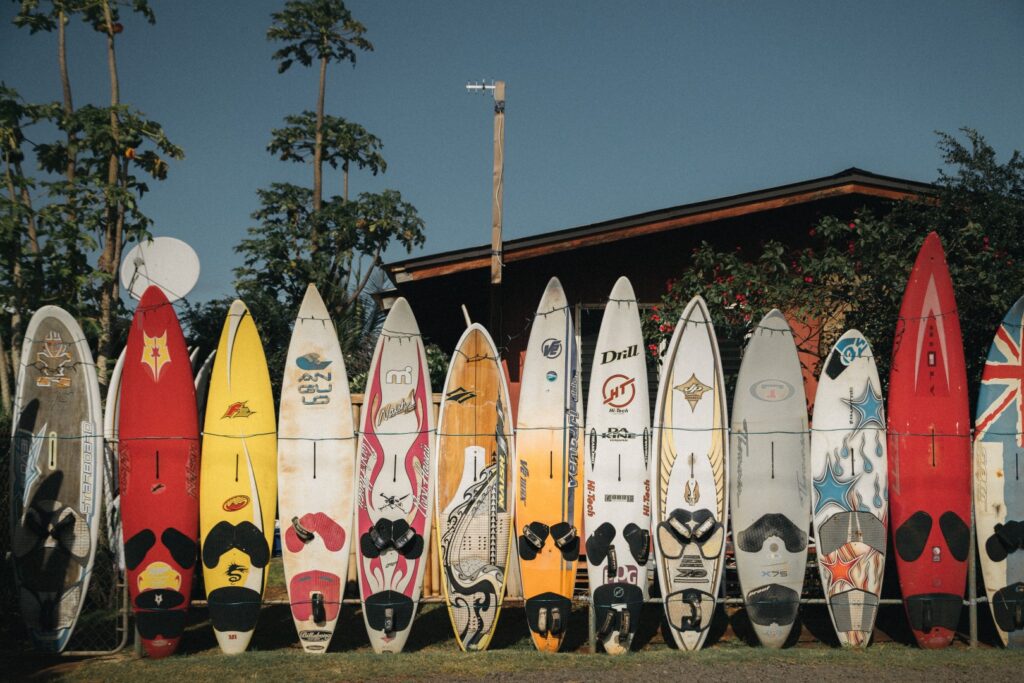
Here’s a good video on choosing gear.
How much does this gear cost? and where can I find it?
So how much does all this cost? Cost varies of course based on the type of gear you purchase, you can find complete board and rig packages from $1500 to $2500+. Because windsurfing like many water sports is a bit of a niche regional sports, your best sources are some popular online shops that cater to water sports, or if you live in a popular coastal area your local surf shop might have equipment as well. Some popular online shops are: Search those shops for complete Windsurf packages, Some of the more popular internet retailers.
- Bigwinds.com
- Liquid surf and Sail
- Isthmus Sailboards
- The-House
- North Beach Windsurfing (FL, USA)
- Wind , North Carolina
- H20-Sports Co.UK
You may also be able to find used gear on online marketplaces like Ebay or Craigslist. The one note on used gear make sure its recent gear (last 10 years) as lots of vintage gear from 1980’s 90s is sold online , but its too out of date to be practical to learn on or get parts for since equipment standards have changed a bit since that period..
Where and When to go Windsurfing? Locations and the wind
As the name implies wind surfing requires a steady , moderately strong wind to allow you to have fun out on the water. But while you’re learning even very low winds 5kts+ will give you something to play around with and practice your low wind sail and board handling skills.
A great resource to find out about window conditions in your favorites spots are websites such as the ones below, they provide a timely wind forecasts and sailing weather conditions , wind direction, strength and other relevant weather info:
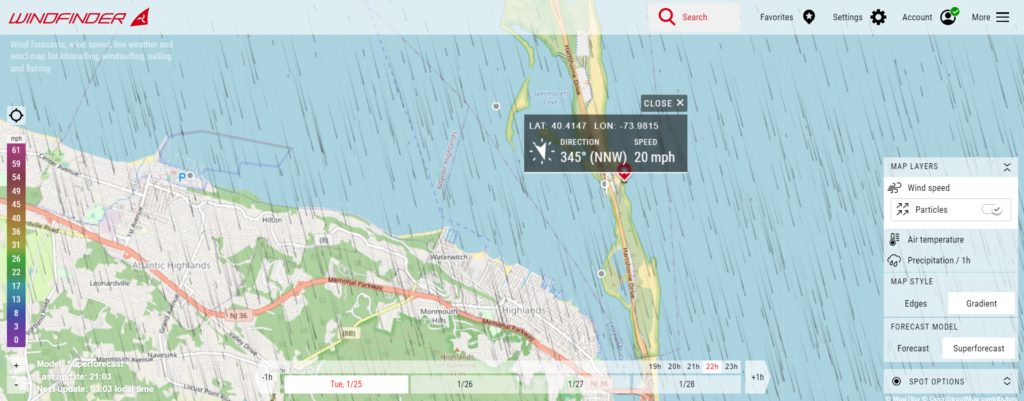
After figuring out the wind situation the next obvious question is where . Obviously places closest to you would be best , provided they have suitable water conditions.. Windsurfing can be attempted anywhere where there’s enough wind and water, but generally the best places are.
- shallow bays, beaches
- lakes with minimal obstructions
- Wide slow moving rivers,with minimal obstructions
Any place with lots of shallow calm water, and large wide open area so the wind flow without too much turbulence, with few to no hills or mountains to block the wind are the best places to begin. But its not just beaches, there’s a lot of lakes and rivers where you can windsurf on… Obviously you will be limited to the areas near where you live, so check the different beaches if you live by the shore and ask around various forums like on Reddit r/windsurfing/ .
If you’re looking to travel to explore or just want to have a great windsurfing vacation here are some of the top world wide locations with both excellent wind and water conditions. Most of these locales have shops that cater to Windsurfers and kite surfers so you can rent gear from them and leave you equipment at home.
- Maui, Hawaii, USA, For many, Maui is a windsurfing mecca. With water temperatures above 80°F (26°C) throughout the year and strong, reliable trade winds between May and October, how can it not be? Note some of the more popular locations (like Ho’okipa & Kanaha Beaches) are wave surfing for more advanced surfers, so stick to beginner spots if your learning, plenty of those in Hawaii.
- Lake Garda, Italy: the largest lake in Italy is very popular European location, besides its scenic beauty their are two reliable winds here, and they are certainly world class.
- Lac Bay, Bonaire, Caribbean: ‘Lac Bay’ in Bonaire is perfect for beginners, or those who are totally new to the sport. You can take out big boards and small sails and have no risk of drifting into the Atlantic. Also right next door Aruba has some fantastic locations.
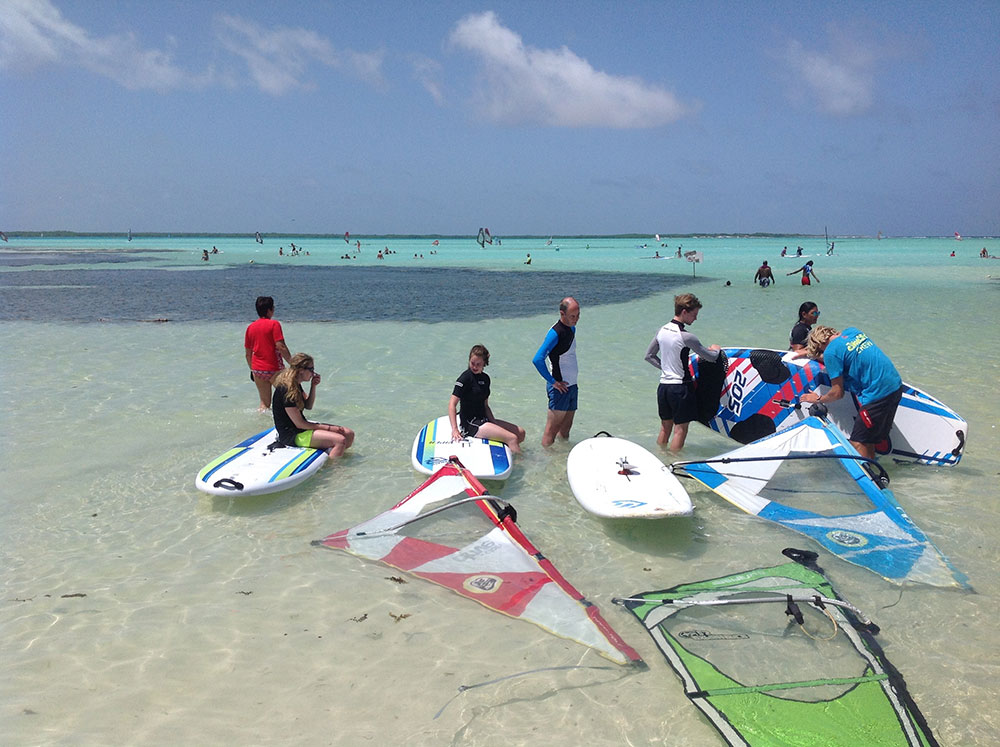
- Vassiliki, Lefkada, Greece: Greece has many fabulous locations, This friendly harbor village situated on the island of Lefkada has a sense of eternal sunshine and action. Tavernas, hot sun, quaint markets, mega mountain bike tracks and windsurfing what more can you ask for. Also in Greece another very popular spot is Prasonisi, Rhodes.
- Cabarete, Dominican Republic: reliable, steadfast winds Cabarete is certainly in the running for world class. Its crystal clear Caribbean waters, eye wateringly white sands, engulf you in this island cloud of unspoiled and untouched heaven.
- Check out this link for more https://magazine.vividalifestyle.com/top-11-windsurfing-spots-in-the-world/
Is Windsurfing an extreme sport? Safety
Windsurfing in its most basic forms is a very safe and approachable sport. Sure if your’re a daredevil there is a risky & extreme big wave surfing , but for most folks, its a very safe sport, and the safety issues are mostly the same as with any other open water activity like surfing, kayaking, paddle boarding or open water swimming etc..
The biggest safety issue with Windsurfing is simply the open water conditions. Wind and sea conditions should always dictate how far you go or how long you stay out on the water. If you’re new to windsurfing, only go out when the wind is blowing on-shore, or cross-shore winds, do not tempt fate and go out in off-shore winds, since you may drift further out than your ability to get back.
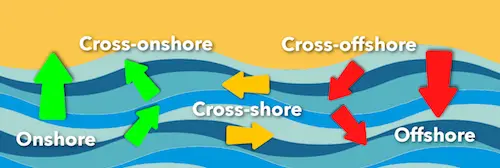
You should use sound judgement when deciding on a particular location watch out for obstructions like hidden rocks, rough surf , dangerous swells or currents. Also pay particular attention to changing weather conditions , and any impending weather like thunderstorms that can make it dangerous to be out on the water, make sure weather is not above your level (too high winds and dangerous surf conditions) , and be ready to head for shore if it changes for the worse. Also be mindful of busy waterways especially during the summer months, since boaters, jet skiers and others on the water may pose hazards if they aren’t paying attention to you..
Finally, Its best to equip yourself with some basic pieces of safety gear will give you added protection.
- a life vest or impact vest will make sure your floatation is a non issue. Good news when you fall off your board the sail keeps it in the water nearby so, you don’t need a leash like in surfing.
- a water proof cell phone case + cell phone will provide you with a communications ability if you have equipment failure, or just need help. Have the number of you local water rescue in your contact list, or you can always contact your emergency services.
- learning self rescue techniques will come in handy should you have an equipment breakdown or other issue out on the water.
- Helmet (more advanced): As you get better and faster, the risk of falling of your board at 20kts+ might mean investing in a water sports helmet is recommended, also if you’re an advanced rider and take up windsurfing with a foil, a helmet is good protection, but generally starting out when the speeds are slow its optional.
- if you have an issue stay with your board and rig, not only will it provide you a buoyant platform but will make you more visible if rescue is necessary. You can always travel faster paddling your board then swimming, if the situation is extreme , you can unclip you rig and paddle your board to shore, but practicing self-rescue shown below is preferrable.
Windsurfing: Community
Depending on your location you will find others that share the same interest and because of the niche nature of the sport , you will quickly get to know most of the locals at your favorite spot. Again check popular forums for communities in your area. Check places Reddit r/Windsurfing or iWindsurf to find about about locations , weather , gear sales and tips and tricks as you get into the sport.
That’s the basics, seems like a lot, and yes, its a bit to take in all out once. Windsurfing like any other endeavor requires practice, it will take time on the water to get proficient at the basics and even more time to begin to master the fundamentals, but the fun you’ll have out there is well worth it. What I can’t do is capture the thrill and fun of windsurfing, maybe this video below will…
So go take some lessons and give it a try.. Happy Sailing!
I live in Brazil cna you recommend some good spots to visit?
What’s the best board to get?